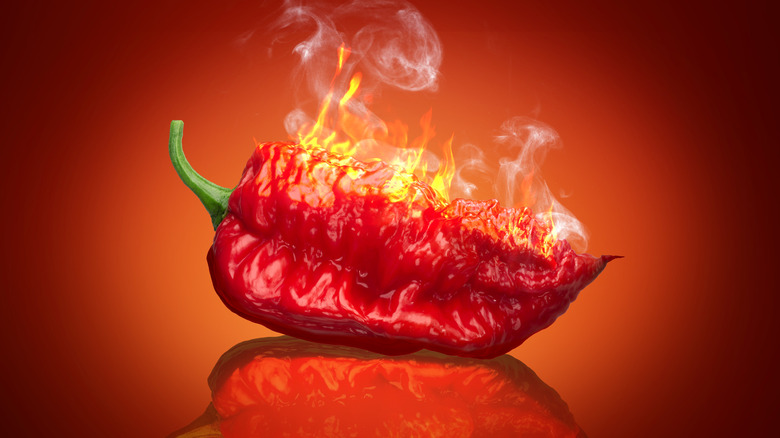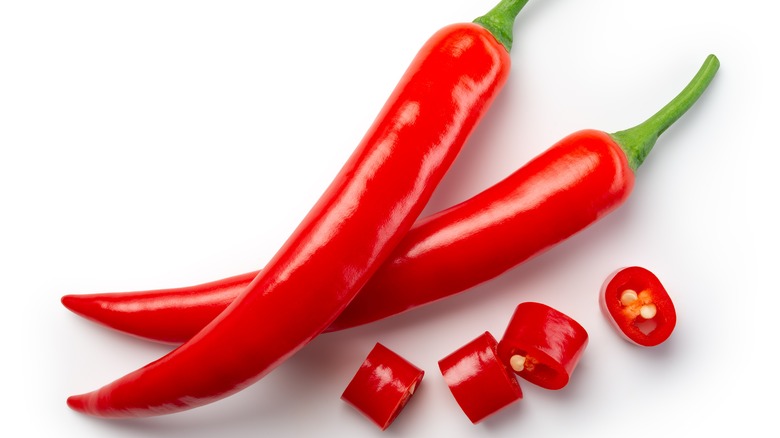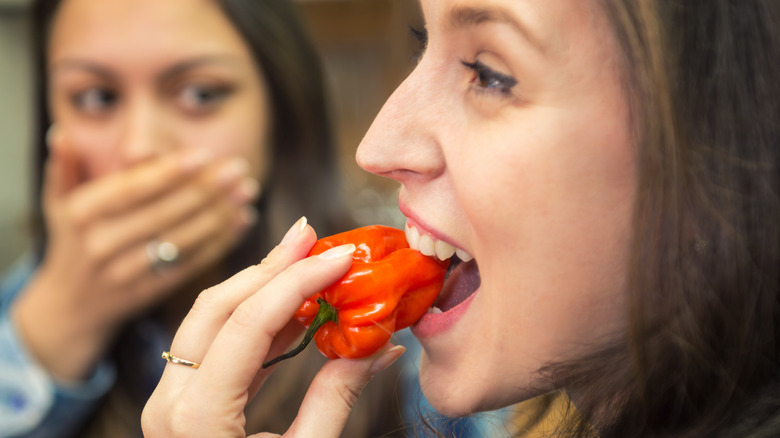It's Pretty Dangerous To Microwave Spicy Peppers. Here's Why
What happens to your body when you eat a super-hot chile pepper has been described as protective flushing: think sweating, tingling, and watery eyes and mouth. The intense feeling of heat and pain can sear a lasting memory. Capsaicin, an odorless, flavorless chemical compound in chiles triggers the reaction. For chile-eating contest participants, the endorphin and dopamine release associated with munching on spicy peppers can make pain feel like a small price to pay for a natural high. For others, pedestrian levels of heat are plenty.
In chile peppers, capsaicin is found in the placenta, more commonly known as the pith. It's that spongy bit of white tissue attaching the seeds to the top of the pepper. The veins attaching the pith to the pepper walls also contain capsaicin. The chemical is the main reason that, for the spice-averse and spice lovers alike, microwaves and hot chiles should not mix. As some cooks can tell you, the painful part of eating a chile can affect you even if you've never taken a bite.
Hurt so good
As a chemical, capsaicin has some beneficial effects on the body. It's thought to reduce pain and boost metabolism in some.
The dose is important, however, and not everyone responds the same way. The Scoville Scale ranks peppers by heat level, and the higher up on the scale a pepper sits, the greater the chances of an eater having unpleasant side effects. These could include headaches, runny nose, cramps, nausea, vomiting, and diarrhea.
Capsaicin is also an irritant to the skin and mucosal linings. Casual home cooks, especially those with any experience preparing fresh salsas, know that handling the seeds of a spicy jalapeno or habanero is asking for a burning sting that can last hours if not the entire next day. Those who have experimented with throwing sliced spicy peppers instead of whole into stir fry also know the pain of having effectively cooked pepper in the name of a homemade meal. That "Oh, no. I maced myself" feeling can easily come from a mistake with the microwave.
Honey, I maced myself
The capsaicin molecules of a spicy pepper will vaporize at high temperatures, effectively releasing it into the air and, you guessed it, pepper spraying everyone unfortunate enough to inhale that painful airborne punch. In some cases, the effects have been enough to evacuate entire apartment buildings. Count on these painful results from inhalation: trouble breathing, coughing, sneezing, burning eyes.
One day, a synthetic capsaicin called capsazepine might make you invincible to the pain of an atomic-level spicy bite. Until then, you can try to neutralize the burn from spicy peppers with all the usual tactics: dairy, acidic ingredients, and foods that are high in carbohdyrates. That's if you ate it. If you inhaled some fiery fumes, however, get away from the offending airborne area, flush your eyes with water, and wait for the sweet mercy of time.
Until then, keep your peppers away from the microwave. Unless, of course, you're looking for trouble.


